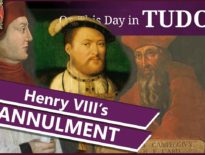On this day in Tudor history, on the night of 30th/31st May 1533, as part of the celebrations for Queen Anne Boleyn’s coronation, which was scheduled for 1st June, eighteen men were created Knights of the Bath.
What did this mean? What happened in this night-long ceremony?
Find out in today's talk.
Also on this day in Tudor history, three years later on 30th May 1536, Henry VIII married his third wife, Jane Seymour. Find out more in last year’s video:
Also on this day in history:
- 1472 – Death of Jacquetta de Luxembourg, Duchess of Bedford, Countess Rivers and mother of Elizabeth Woodville. Her resting place is not known.
- 1525 – Wolsey proclaimed the King's pardon for the rebels involved in the Amicable Grant Rebellion.
- 1555 – Burnings of Protestant martyrs John Cardmaker (clergyman) and John Warne (upholsterer) at Smithfield.
- 1582 – Executions of Jesuit priest Thomas Cottam at Tyburn. He was hanged, drawn and quartered along with priests William Filbie, Luke Kirby, and Laurence Richardson. He refused the offer of a pardon, as it would have involved him acknowledging Queen Elizabeth I as Supreme Head of the Church.
- 1593 – Death of Christopher Marlowe, playwright and poet. He was stabbed to death at a house in Deptford Strand, near London, in what has been described as a "tavern brawl". However, he was killed in a private room of a house, not a tavern. Some believe that he was assassinated.
- 1630 – Death of Emanuel Scrope, Earl of Sunderland. He was buried at Langar in Nottinghamshire. Scrope was married to Philadelphia Carey, granddaughter of Mary Boleyn.
- 1640 – Death of Sir Peter Paul Rubens, painter, in Antwerp. It is thought that he died of complications caused by gout. He was buried in the family vault at St Jacob's Church, Antwerp.
Transcript:
On this day in Tudor history, on the night of 30th/31st May 1533, as part of the celebrations for Queen Anne Boleyn’s coronation, which was scheduled for 1st June, eighteen men were created Knights of the Bath.
Chronicler Edward Hall records:
“On Friday at dinner served the king all such as were appointed by his highness to be knights of the bath, which after dinner were brought to their chambers, and that night were bathed and shriven according to the old usage of England, and the next day in the morning the king dubbed them according to the ceremonies thereto belonging whose names ensueth.
The Marquess of Dorset, Sir William Windsor, The Earl of Derby, Sir Frances Weston, The Lord Clifford, Sir Thomas Arrundell, The Lord Fitzwater, Sir John Huddelston, The Lord Hastings, Sir Thomas Poynings, The Lord Mountegle, Sir Henry Savile, Sir John Mordaunt, Sir George Fitzwilliam, The Lord Vaux, Sir John Tyndall, Sir Henry Parker, Sir Thomas Germayne.”
A record in Letters and Papers adds further names: “Mr. Corbet, Mr. Wyndham, John Barkely… Ric. Verney of Penley… Rob. Whitneye of Gloucestershire”.
Major-General Sir George Younghusband, in his book “The Tower from Within”, describes this traditional coronation ceremony in relation to the coronation of King Henry IV, when 46 men were created Knights of the Bath. He writes that forty-six baths were arranged in one of the halls of the White Tower. Each bath had a canopy over it and was filled with warm water and draped with clean sheets. The forty-six knights bathed and then the king led a procession into the hall. The king then approached each knight, still in his bath, and dipped his finger into the bath water and made the sign of the cross on the knight’s bare back. While he did this, the king said:
“You shall honor God above all things; you shall be steadfast in the faith of Christ; you shall love the King your Sovereign Lord, and him and his right defend to your power; you shall defend maidens, widows, and orphans in their rights, and shall suffer no extortion, as far as you may prevent it; and of as great honor be this Order unto you, as ever it was to any of your progenitors or others.”
When he had done this to all forty-six knights, King Henry IV processed out of the hall. The knights then dried themselves off and were put to bed in “beds with rich hangings”, which had been placed behind their baths. After they had rested for a while, they were summoned to rise by the curfew bell of the Bell Tower. Their esquires helped them dress as monks in long brown woollen cassocks, with cowls, then they processed into St John’s Chapel as music played. Their new helmets, armour, swords and spurs had been arranged around the high altar, “and before these each Knight knelt in devotion, and watched his armour all night”.
That is what happened at Henry IV’s coronation in 1399 and it gives us a good idea of what took place on the night of 30th May 1533. Of course, it would have been King Henry VIII as monarch dubbing the knights, not Queen Anne Boleyn.



Leave a Reply